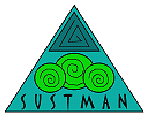
Underplanting of beech beneath spruce: Selection of sites
It has been estimated that at least 6 to 7 million hectares of pure Norway spruce (Picea abies) in Europe is located outside its natural range. At least about 4 to 5 million hectares are located on sites naturally dominated by broadleaved species or mixed tree species. Former mixed broadleaved forests were overexploited due to agricultural use, litter harvesting, grazing and due to the need of fuel.
Simultaneously, an urgent need for timber as a consequence of the industrialization process promoted afforestation with fast growing Norway spruce. During the last 200 years, Norway spruce was chosen because of its high growth rate, it was easily established and tended and it was not favoured by browsing animals.
Accordingly are parts of the forested landscape in Western and Central Europe dominated by Norway spruce plantations. These forests have with time resulted in a higher exposure to forest decline, windthrows, pests, drought and soil deterioration. Climate change with increasing probability of climatic extremes, such as storms, furthermore illustrates the vulnerability of Norway spruce. In addition, the spruce forests have been associated with lower public acceptance because of the changed or decreased biodiversity but also due to the drastic change of the environment and landscape.
For economical, environmental and social reasons, restoration of the former mixed broadleaved forests is believed to be a step towards sustainable forestry. One type of restoration activity is conversion from Norway spruce to broadleaves. The conversion could be accomplished by different methods, where one of these is underplanting of European beech (Fagus sylvatica) beneath spruce shelterwoods.
During the last decades, underplanting of beech in spruce shelterwoods have been promoted in several parts of Western Europe. However, little research has been done, and the SUSTMAN-project provide a comprehensive fundament for forest conversion through planting of broadleaves under Norway spruce shelterwoods.
| To be able to develop underplanting of broadleaved tree species under Norway spruce trees as a silvicultural tool for conversion of Norway spruce forest, EU finances the research project SUSTMAN (QLRT: 2001 – 00851), coordination Prof. Dr. M. Kazda, University Ulm, www.sustman.de). SUSTMAN is a project involving forest researchers from Austria, Czech Republic, Germany, Slovenia and Sweden. The project is running over three years from 2002 until 2005 with a budget of about 1.6 million euros. One important task is transfer of knowledge to practical forestry. The project will therefore produce a silvicultural management guideline for European forest managers when underplanting is put into practice. This leaflet summarize the main information within that guideline which in complete form will be published in Czech, English, German and Slovenian. |
Underplanting in the participating countries
Underplanting of beech in spruce shelterwood is an old method, practised in many countries for at least a couple of decades. In Germany, underplanting activities started already in the first half of the nineteenth century. Only a few per cent of the Norway spruce area have been underplanted with broadleaves. However, in some German districts as much as 40-60% of the Norway spruce area was underplanted with broadleaves. Due to biodiversity reasons many foresters believe that underplanting will increase in the future.
Other reasons for conversion is to create stable stands and improve soil conditions. In the countries involved in SUSTMAN, preferred species to underplant is beech, but Sycamore maple, lime, ash, oak and Douglas fir, hornbeam, rowan, cherry have also been used. Local provenances are preferred and planting is the dominant method. Direct seeding is seldom used and regarded as unreliable. Bare-root seedlings are preferred with a large variation in height, 15 cm – 100 cm, and in age of seedlings, 1 to 5 years. The number of seedlings used during underplanting greatly fluctuates from 200 – 10 000 seedlings per hectare.
Basal area of the Norway spruce stand is also very variable from less than 20 till more than 50 square meters. Canopy management does not follow any standard methods, as the shelter trees can be kept from 5 till up to 20 years and some even up till 40 years and more. Consequently, there are a number of ways to remove the shelter trees. Mostly, shelterwood trees are removed manually by chain saw.
Selection of sites for underplanting
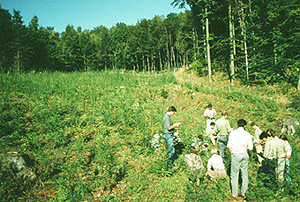
Clear-cutting followeg by planting. Photo: R. Lässig (WSL)
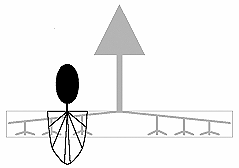
Fig. 1: Shelterwood mature spruce tree (gray) with underplanted beech seedling (black)
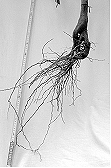
Fig. 1: Shelterwood mature spruce tree (gray) with underplanted beech seedling (black)
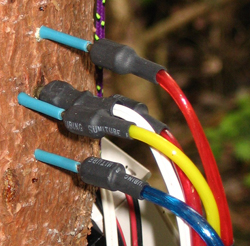
Spruce transpire about 35 times more water per day than beech (Sap flow measurement)
The decision process can be divided into three steps.
1. Evaulation of the risk factors of Norway spruce
2. Assessment of the suitability of broadleave tree species with site selection
3. Selection of methods for conversion
1. Evaluation of risks
In the first step of the decision process, the risk potential for Norway spruce stands has to be determined. Two important parameters are site factors and stand factors. The former leads mainly to drought risk that originates from site characteristics such as low rooting depth either through shallow soil or through restricted rooting due to impaired soil aeration. Both limit water availability for tree roots when climate extremes such as long-lasting high summer temperatures and irregular precipitation induces drought stress. The reduced vigour of Norway spruce during such periods decreases the tree resistance against bark beetle, which together with drought as primary stress causes the lethal damage.
The second parameter, the stand factors are mainly linked to the forest stand and its management. There, especially high tree numbers increases the water loss due to rain interception on crowns and branches and thus less water can reach the soil. Furthermore, slender trees with a high height/diameter ratio became increasingly unstable and storm events can easily disintegrate existing forest stands. Also, restricted rooting especially on heavy soils and high water table limit the rooting depth and impair of tree anchorage, thus further increasing tree instability. The evaluation of risk zones of Norway spruce could be accomplished with help of climate characteristics as temperature sum and annual average precipitation.
2. Assessment of suitability
The assessment of suitable sites for broadleaves is based on soil water availability, soil nutrient regime and climate. Many broadleaved tree species require fertile sites for good growth. In the SUSTMAN-project a thorough assessment of the research sites were undertaken by e.g. analysis of mineral soil samples (resulting in pH values, base saturation values etc), estimation of water field capacity and soil moisture. Information from former land use and growth of Norway spruce stands may also indicate where fertile sites can be found.
3. Selection of methods for conversion
Management decisions are related to the resource input level. The resource input will in most cases directly depend from the magnitude of expected timber production, general benefits and subsidies. In the case the decision to convert the Norway spruce stands is positive, the next step in the conversion process is the specification of stands with the highest conversion priority.
General management objectives rely on timber market prices, taxes regulations and subsidies for damage events and broadleaf species introduction, respectively. They also take in account the potential risk of Norway spruce plantations that is inherently present from previous calamities. The management objective for broadleaf species introduction once more has to consider the stability of Norway spruce in order to judge the applicability of advanced planting. Requirements of the broadleaf species regarding the light and nutrient supply has to be reviewed facing the site characteristics.
The final decision to perform advanced planting as a mean for the conversion of Norway spruce stands must agree with the resource input level. The resource input is strongly linked to the intensity of conversion process (costs per hectare) and to the area subjected to conversion, both will differ substantially among the forest companies. Taking in account the heterogeneity of forest systems in countries with a large share of man-made Norway spruce monocultures there will be a variety of approaches.
Depending on the management decision for the future tree generation, several regeneration methods based on a various of felling regimes from clear-cut to group-selection or single-tree harvesting can be chosen. Clear-cutting followed by planting in the open will be widely used in potentially unstable stands, where thinning of the spruce shelter bears high risks for the stability of the remaining trees. Stable Norway spruce stands generally have a high potential to be replaced by broadleaf species through advanced planting.
Root distribution and competition
The typical root system of Norway spruce is shallow with maximum root densities in the organic and upper mineral soil layer. In contrast to spruce, beech trees have root systems distributed to greater depths (Figure 1). Severe belowground competition between spruce and beech trees can occur mainly in the first years of underplanting, when young beech trees are restricted to the top soil layers.
In order to study root biomass and distribution of the underplanted beech trees on SUSTMAN plots, a new technique using supersonic air stream was applied for the excavation of roots. Root systems of introduced trees were opened this way on all six SUSTMAN plots. Results show, that most fine roots of spruce were concentrated on the top 20 cm of the soil. There were hardly any spruce roots found below 40 cm soil depth. Vertical root distribution shows clear differences between the two species. Roots of underplanted beech go much deeper than spruce roots and are found down to more than 1 m soil depth.
Thus, beech seedlings may minimize interspecific competition in this way. As spruce trees show greater rooting depths in the vicinity of the stem, it is important to ensure a certain minimum distance between underplanted beech seedlings and mature spruce trees. Furthermore, it is of great importance that advanced planting emphasises also sub-soil properties that allow beech to build up deep root systems.
In this respect, the deformation of root systems may play an important role. Parts of beech trees excavated in this project showed significantly distorted main root systems (Figure 2). Such deformations result from root cut prior to planting and possibly from irregaular placement of roots during planting. Reduces rooting depths caused by such deformed root systems may impair the competitive ability of beech trees and may lead to reduced stability of such beech plantations in later ages.
Sap flow (transpiration of water) is a good indicator of the functional state of root systems. In SUSTMAN, the Heat Field Deformation method was applied for sap flow measurements in seedlings and spruce trees. In general, beech seedlings transpired about 1.5 kg water per day in July and August 2002, which was a medium dry period.
For the same period in 2003, which was a very dry year, beech saplings transpired 2.3 kg water per day. In contrast to this, mature spruce trees transpired about 35 times more (54.5 kg per day in 2002). Sap flow measurements indicate, that mature spruce trees are highly sensitive to drought, as their sap flow decreased several times during summer in periods with little rain.
In contrast, underplanted beeches are more drought-tolerant and their sap flow continued without major changes over all periods when spruce was down. Our studies and results from literature confirm that root competition is stronger in the vicinity of Norway spruce trees. Especially under drought conditions advanced regeneration suffers when established close to stems of Norway spruce. Planting should therefore not be carried out in these spots. Another possibility to avoid root competition is thinning of the shelterwood tress, or an earlier release cut than usually applied.
Contact
- Marian Kazda, coordination
University Ulm, Department of Systematic Botany and Ecology
Albert Einstein-Allee 11, D-89081 Ulm
